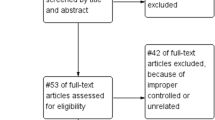Abstract
Purpose: To evaluate the impact of postoperative treatment with an oral enzyme (OE) preparation given complementary to an antineoplastic therapy in patients with breast cancer. Methods: The design of this epidemiological study was a retrolective cohort analysis with parallel groups. Design and conduct of the study were performed to current standards for prospective, controlled clinical trials. A cohort of 2339 breast cancer patients undergoing surgical intervention and radio-, chemo- or hormonal therapy were studied in 216 centres. Of the 2339 patients, 1283 received complementary treatment with OE and 1056 did not receive OE. Patients with other complementary medications were excluded and the final analysis was performed with the data from 649 patients, of whom 239 (37%) were additionally treated with OE (test group) and 410 (63%) without OE (control group). The median follow-up time for the test group was 485 days and for the control group 213 days. The primary endpoint of the study was to determine whether complementary treatment with OE can reduce typical disease- or therapy-associated signs and symptoms (gastrointestinal symptoms, mental symptoms, dyspnoea, headache, tumour pain, cachexia, skin disorders, infections, and side effects associated with the antineoplastic therapy) in patients with breast cancer. Imbalances for causal effects (covariates) were adjusted for by means of the propensity score. Outcome analysis was performed by estimating the linear regression between change in symptom score and propensity score with all data and using this regression line to calculate the change in symptom score which would be expected for each patient. Tumour-associated events (recurrence, metastasis, and death) were evaluated in terms of the number of events observed and time to event. The safety of treatment with OE was analysed in terms of the number and severity of adverse events, their duration, treatment and outcome. Results: For all symptoms except tumour pain, the adjusted mean improvement in symptom scores was larger in the test group than in the control group. The adjusted difference was statistically significant for all symptoms, except tumour pain and infections. The results show that the typical disease- and therapy-associated signs and symptoms in patients on complementary therapy with OE during postoperative treatment were significantly less. For 75% of the test group and 55% of the control group the physician recorded “no signs and symptoms”. A clear reduction in the side effects of radiotherapy and chemotherapy was documented in 74% of the test group and 55% of the control group. Analysis of survival, recurrence, and metastasis demonstrated a reduced number of events in the test group. There was evidence of a beneficial influence of OE on time to event, although the median observation time was too short in these breast cancer patients to draw definite conclusions. The safety component was judged in 98% of the test group and 76% of the control group as “very good” or “good”. In the total sample of 2339 patients, the rate of OE-associated adverse reactions was 3.2%. All side effects were mild to moderate gastrointestinal symptoms. Conclusion: Complementary treatment of breast cancer patients with OE improves the quality of life by reducing signs and symptoms of the disease and the side effects of adjuvant antineoplastic therapies. This epidemiological retrolective cohort analysis provides evidence that the patients may also gain benefit by a prolongation of the time to event for cancer recurrence, metastasis and survival. OE was generally well tolerated.
Similar content being viewed by others
Author information
Authors and Affiliations
Rights and permissions
About this article
Cite this article
Beuth, J., Ost, B., Pakdaman, A. et al. Impact of complementary oral enzyme application on the postoperative treatment results of breast cancer patients – results of an epidemiological multicentre retrolective cohort study. Cancer Chemother Pharmacol 47 (Suppl 1), S45–S54 (2001). https://doi.org/10.1007/s002800170009
Issue Date:
DOI: https://doi.org/10.1007/s002800170009




